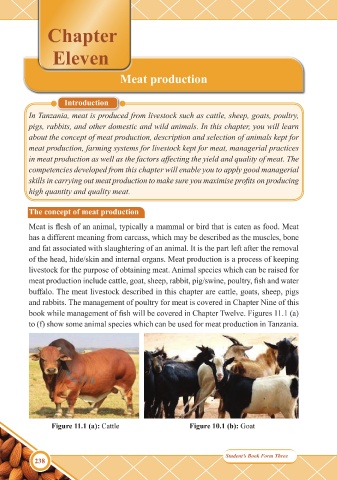Page 249 - Agriculture_Form_Three
P. 249
Chapter
Eleven
Meat production
Introduction
In Tanzania, meat is produced from livestock such as cattle, sheep, goats, poultry,
pigs, rabbits, and other domestic and wild animals. In this chapter, you will learn
about the concept of meat production, description and selection of animals kept for
meat production, farming systems for livestock kept for meat, managerial practices
in meat production as well as the factors affecting the yield and quality of meat. The
competencies developed from this chapter will enable you to apply good managerial
skills in carrying out meat production to make sure you maximise profits on producing
high quantity and quality meat.
The concept of meat production
Meat is flesh of an animal, typically a mammal or bird that is eaten as food. Meat
has a different meaning from carcass, which may be described as the muscles, bone
and fat associated with slaughtering of an animal. It is the part left after the removal
of the head, hide/skin and internal organs. Meat production is a process of keeping
livestock for the purpose of obtaining meat. Animal species which can be raised for
meat production include cattle, goat, sheep, rabbit, pig/swine, poultry, fish and water
buffalo. The meat livestock described in this chapter are cattle, goats, sheep, pigs
and rabbits. The management of poultry for meat is covered in Chapter Nine of this
book while management of fish will be covered in Chapter Twelve. Figures 11.1 (a)
to (f) show some animal species which can be used for meat production in Tanzania.
Figure 11.1 (a): Cattle Figure 10.1 (b): Goat
Student’s Book Form Three
238
10/01/2025 12:32
AGRICULTURE FORM 3 9.11.2022.indd 238
AGRICULTURE FORM 3 9.11.2022.indd 238 10/01/2025 12:32

